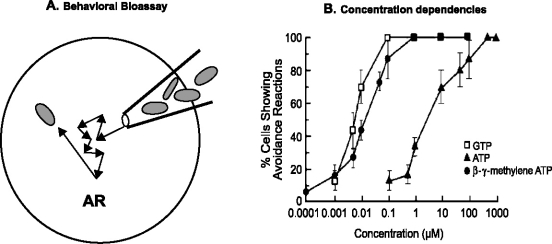Figure 1.
(A) The behavioral bioassay for avoiding reactions (AR) involves using a micropipet to transfer cells into a test solution and then observing their swimming behavior under a dissecting microscope. Individual cells are scored as either showing an AR or not. (B) The responsiveness can be quantitated by repeating this observation many times. For example, if 10 cells are observed and eight cells show AR, the percent cells showing AR = 80%. For each data point in B, 3 blocks of 10 cells each were pooled so the mean ± SD has an n = 3. The EC50 (concentration where the ligand is 50% effective) is about 8.0 nM for GTP (open squares), about 10.0 nM for β-γ methylene ATP (closed circles) and 5.0 µM for ATP (closed triangles) in these cells. The data shown in B were obtained with Tetrahymena and the test solution contained 10 mM Tris-base, 0.5 mM MOPS, 1.0 mM disodium tartarate, 50 µM CaCl2 and pH = 7.0. (From Kim et al. [31].)

